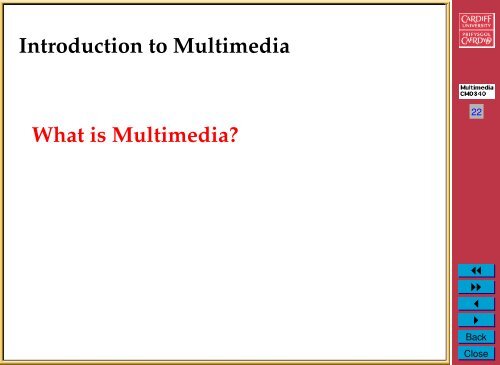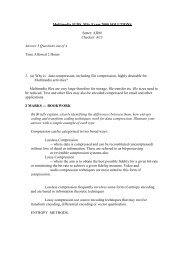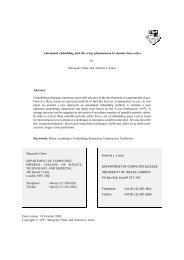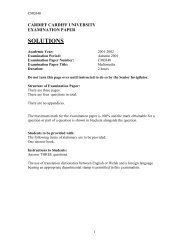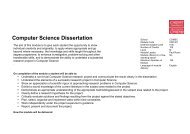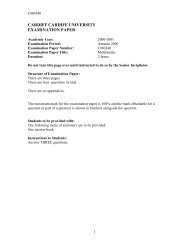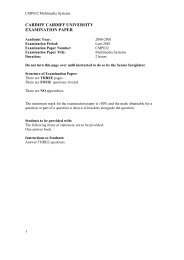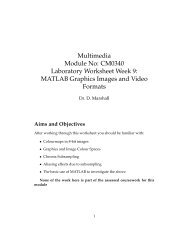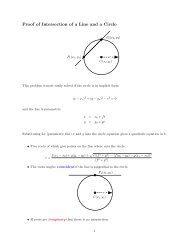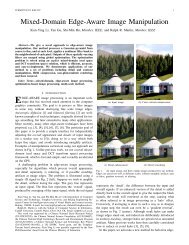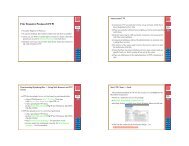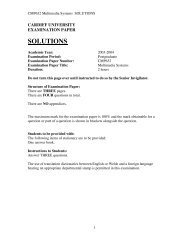CM0340 Chapter 1: Introduction to Multimedia
CM0340 Chapter 1: Introduction to Multimedia
CM0340 Chapter 1: Introduction to Multimedia
You also want an ePaper? Increase the reach of your titles
YUMPU automatically turns print PDFs into web optimized ePapers that Google loves.
<strong>Introduction</strong> <strong>to</strong> <strong>Multimedia</strong><br />
What is <strong>Multimedia</strong>?<br />
22<br />
◭◭<br />
◮◮<br />
◭<br />
◮<br />
Back<br />
Close
What is <strong>Multimedia</strong>?<br />
<strong>Multimedia</strong> can have many definitions these include:<br />
(A computer system perspective)<br />
<strong>Multimedia</strong> means that computer information can be<br />
represented through audio, video, and animation in addition <strong>to</strong><br />
traditional media (i.e., text, graphics/drawings, images).<br />
23<br />
◭◭<br />
◮◮<br />
◭<br />
◮<br />
Back<br />
Close
General Definition<br />
A good general working definition for this module is:<br />
<strong>Multimedia</strong> is the field concerned with the computer<br />
controlled integration of text, graphics, drawings, still and moving<br />
images (Video), animation, audio, and any other media where<br />
every type of information can be represented, s<strong>to</strong>red, transmitted<br />
and processed digitally.<br />
24<br />
◭◭<br />
◮◮<br />
◭<br />
◮<br />
Back<br />
Close
<strong>Multimedia</strong> Application Definition<br />
A <strong>Multimedia</strong> Application is an application which uses a<br />
collection of multiple media sources e.g. text, graphics, images,<br />
sound/audio, animation and/or video.<br />
25<br />
◭◭<br />
◮◮<br />
◭<br />
◮<br />
Back<br />
Close
What is HyperText and HyperMedia?<br />
Hypertext is a text which contains links <strong>to</strong> other texts.<br />
The term was invented by Ted Nelson around 1965.<br />
26<br />
◭◭<br />
◮◮<br />
◭<br />
◮<br />
Back<br />
Close
HyperText Navigation<br />
Traversal through pages of hypertext is therefore usually<br />
non-linear (as indicated below).<br />
This has implications in layout and organisation of material —<br />
and depends a lot on the application at hand.<br />
27<br />
◭◭<br />
◮◮<br />
◭<br />
◮<br />
Back<br />
Close
Hypermedia<br />
HyperMedia is not constrained <strong>to</strong> be text-based. It can include<br />
other media, e.g., graphics, images, and especially the<br />
continuous media – sound and video.<br />
28<br />
◭◭<br />
◮◮<br />
◭<br />
◮<br />
Back<br />
Close
Example Hypermedia Applications?<br />
Example<br />
29<br />
◭◭<br />
◮◮<br />
◭<br />
◮<br />
Back<br />
Close
Example Hypermedia Applications?<br />
• The World Wide Web (WWW) is the best example of a<br />
hypermedia application.<br />
• Powerpoint<br />
• Adobe Acrobat (or other PDF software)<br />
• Adobe Flash<br />
• Many Others?<br />
30<br />
◭◭<br />
◮◮<br />
◭<br />
◮<br />
Back<br />
Close
<strong>Multimedia</strong> Applications<br />
Examples of <strong>Multimedia</strong> Applications include:<br />
• World Wide Web<br />
• <strong>Multimedia</strong> Authoring, e.g. Adobe/Macromedia Direc<strong>to</strong>r<br />
• Hypermedia courseware<br />
• Video-on-demand<br />
• Interactive TV<br />
• Computer Games<br />
• Virtual reality<br />
• Digital video editing and production systems<br />
• <strong>Multimedia</strong> Database systems<br />
31<br />
◭◭<br />
◮◮<br />
◭<br />
◮<br />
Back<br />
Close
<strong>Multimedia</strong> Systems<br />
A <strong>Multimedia</strong> System is a system capable of processing<br />
multimedia data and applications.<br />
A <strong>Multimedia</strong> System is characterised by the processing,<br />
s<strong>to</strong>rage, generation, manipulation and rendition of <strong>Multimedia</strong><br />
information.<br />
32<br />
◭◭<br />
◮◮<br />
◭<br />
◮<br />
Back<br />
Close
Characteristics of a <strong>Multimedia</strong> System<br />
A <strong>Multimedia</strong> system has four basic characteristics:<br />
• <strong>Multimedia</strong> systems must be computer controlled.<br />
• <strong>Multimedia</strong> systems are integrated.<br />
• The information they handle must be represented digitally.<br />
• The interface <strong>to</strong> the final presentation of media is usually<br />
interactive.<br />
33<br />
◭◭<br />
◮◮<br />
◭<br />
◮<br />
Back<br />
Close
Challenges for <strong>Multimedia</strong> Systems<br />
• Distributed Networks<br />
• Temporal relationship between data<br />
– Render different data at same time — continuously.<br />
– Sequencing within the media<br />
playing frames in correct order/time frame in video<br />
– Synchronisation — inter-media scheduling<br />
E.g. Video and Audio — Lip synchronisation is clearly<br />
important for humans <strong>to</strong> watch playback of video and audio<br />
and even animation and audio.<br />
Ever tried watching an out of (lip) sync film for a long time?<br />
34<br />
◭◭<br />
◮◮<br />
◭<br />
◮<br />
Back<br />
Close
Key Issues for <strong>Multimedia</strong> Systems<br />
The key issues multimedia systems need <strong>to</strong> deal with here<br />
are:<br />
• How <strong>to</strong> represent and s<strong>to</strong>re temporal information.<br />
• How <strong>to</strong> strictly maintain the temporal relationships on play<br />
back/retrieval<br />
• What process are involved in the above.<br />
• Data has <strong>to</strong> represented digitally — Analog–Digital<br />
Conversion, Sampling etc.<br />
• Large Data Requirements — bandwidth, s<strong>to</strong>rage,<br />
Data compression is usually manda<strong>to</strong>ry<br />
35<br />
◭◭<br />
◮◮<br />
◭<br />
◮<br />
Back<br />
Close
Desirable Features for a <strong>Multimedia</strong> System<br />
Given the above challenges the following feature a desirable<br />
(if not a prerequisite) for a <strong>Multimedia</strong> System:<br />
Very High Processing Power — needed <strong>to</strong> deal with large data<br />
processing and real time delivery of media.<br />
Special hardware commonplace.<br />
<strong>Multimedia</strong> Capable File System — needed <strong>to</strong> deliver real-time<br />
media — e.g. Video/Audio Streaming.<br />
Special Hardware/Software needed – e.g. RAID technology.<br />
Data Representations — File Formats that support multimedia<br />
should be easy <strong>to</strong> handle yet allow for<br />
compression/decompression in real-time.<br />
36<br />
◭◭<br />
◮◮<br />
◭<br />
◮<br />
Back<br />
Close
Efficient and High I/O — input and output <strong>to</strong> the file subsystem<br />
needs <strong>to</strong> be efficient and fast. Needs <strong>to</strong> allow for real-time<br />
recording as well as playback of data.<br />
e.g. Direct <strong>to</strong> Disk recording systems.<br />
Special Operating System — <strong>to</strong> allow access <strong>to</strong> file system and<br />
process data efficiently and quickly. Needs <strong>to</strong> support direct<br />
transfers <strong>to</strong> disk, real-time scheduling, fast interrupt<br />
processing, I/O streaming etc.<br />
S<strong>to</strong>rage and Memory — large s<strong>to</strong>rage units (of the order of<br />
hundreds of Tb if not more) and large memory (several Gb<br />
or more). Large Caches also required and high speed buses<br />
for efficient management.<br />
Network Support — Client-server systems common as<br />
distributed systems common.<br />
Software Tools — user friendly <strong>to</strong>ols needed <strong>to</strong> handle media,<br />
design and develop applications, deliver media.<br />
37<br />
◭◭<br />
◮◮<br />
◭<br />
◮<br />
Back<br />
Close
Components of a <strong>Multimedia</strong> System<br />
Now let us consider the Components (Hardware and Software)<br />
required for a multimedia system:<br />
Capture devices — Video Camera, Video Recorder, Audio<br />
Microphone, Keyboards, mice, graphics tablets, 3D input<br />
devices, tactile sensors, VR devices. Digitising Hardware<br />
S<strong>to</strong>rage Devices — Hard disks, CD-ROMs, DVD-ROM, etc<br />
Communication Networks — Local Networks, Intranets,<br />
Internet, <strong>Multimedia</strong> or other special high speed networks.<br />
Computer Systems — <strong>Multimedia</strong> Desk<strong>to</strong>p machines,<br />
Workstations, MPEG/VIDEO/DSP Hardware<br />
Display Devices — CD-quality speakers, HDTV,SVGA, Hi-Res<br />
moni<strong>to</strong>rs, Colour printers etc.<br />
38<br />
◭◭<br />
◮◮<br />
◭<br />
◮<br />
Back<br />
Close
Applications<br />
Examples of <strong>Multimedia</strong> Applications include:<br />
• World Wide Web<br />
• Hypermedia courseware<br />
• Video conferencing<br />
• Video-on-demand<br />
• Interactive TV<br />
• Groupware<br />
• Home shopping<br />
• Games<br />
• Virtual reality<br />
• Digital video editing and production systems<br />
39<br />
◭◭<br />
◮◮<br />
◭<br />
◮<br />
Back<br />
Close
A Brief Look at <strong>Multimedia</strong> Data:<br />
Input and Format<br />
Text and Static Data<br />
• Source: keyboard, speech input, optical character recognition,<br />
data s<strong>to</strong>red on disk.<br />
• S<strong>to</strong>red and input character by character:<br />
– S<strong>to</strong>rage of text is 1 byte per char / more bytes for Unicode.<br />
– For other forms of data (e.g. Spreadsheet files). May s<strong>to</strong>re<br />
format as text (with formatting) others may use binary encoding.<br />
• Format: Raw text or formatted text e.g HTML, Rich Text Format<br />
(RTF), Word or a program language source (C, Pascal, etc..<br />
• Not temporal — BUT may have natural implied sequence e.g.<br />
HTML format sequence, Sequence of C program statements.<br />
• Size Not significant w.r.t. other <strong>Multimedia</strong> data.<br />
40<br />
◭◭<br />
◮◮<br />
◭<br />
◮<br />
Back<br />
Close
Graphics<br />
• Format: constructed by the composition of primitive objects<br />
such as lines, polygons, circles, curves and arcs.<br />
• Input: Graphics are usually generated by a graphics edi<strong>to</strong>r<br />
program (e.g. Illustra<strong>to</strong>r) or au<strong>to</strong>matically by a program (e.g.<br />
Postscript).<br />
• Graphics are usually editable or revisable (unlike Images).<br />
• Graphics input devices: keyboard (for text and cursor control),<br />
mouse, trackball or graphics tablet.<br />
• graphics standards : OpenGL, PHIGS, GKS<br />
• Graphics files usually s<strong>to</strong>re the primitive assembly<br />
• Do not take up a very high s<strong>to</strong>rage overhead.<br />
41<br />
◭◭<br />
◮◮<br />
◭<br />
◮<br />
Back<br />
Close
Images<br />
• Still pictures which (uncompressed) are represented as a<br />
bitmap (a grid of pixels).<br />
• Input: digitally scanned pho<strong>to</strong>graphs/pictures or direct from<br />
a digital camera.<br />
• Input: May also be generated by programs “similar” <strong>to</strong> graphics<br />
or animation programs.<br />
• S<strong>to</strong>red at 1 bit per pixel (Black and White), 8 Bits per pixel<br />
(Grey Scale, Colour Map) or 24 Bits per pixel (True Colour)<br />
• Size: a 512x512 Grey scale image takes up 1/4 MB, a 512x512<br />
24 bit image takes 3/4 MB with no compression.<br />
• This overhead soon increases with image size — modern<br />
high digital camera 10+ Megapixels ≈ 29MB uncompressed!<br />
• Compression is commonly applied.<br />
42<br />
◭◭<br />
◮◮<br />
◭<br />
◮<br />
Back<br />
Close
Audio<br />
• Audio signals are continuous analog signals.<br />
• Input: microphones and then digitised and s<strong>to</strong>red<br />
• CD Quality Audio requires 16-bit sampling at 44.1 KHz<br />
Even higher audiophile rates (e.g. 24-bit, 96 KHz)<br />
• 1 Minute of Mono CD quality (uncompressed) audio requires<br />
5 MB.<br />
• 1 Minute of Stereo CD quality (uncompressed) audio requires<br />
10 MB.<br />
• Usually compressed (E.g. MP3, AAC, Flac, Ogg Vorbis).<br />
43<br />
◭◭<br />
◮◮<br />
◭<br />
◮<br />
Back<br />
Close
Video<br />
• Input: Analog Video is usually captured by a video camera<br />
and then digitised.<br />
• There are a variety of video (analog and digital) formats<br />
• Raw video can be regarded as being a series of single images.<br />
There are typically 25, 30 or 50 frames per second.<br />
• E.g. A 512 × 512 size monochrome video images take 25 ×<br />
0.25 = 6.25MB for a second <strong>to</strong> s<strong>to</strong>re uncompressed.<br />
• Typical PAL digital video (720 × 576 pixels per colour frame)<br />
≈ 1.24 × 25 = 31MB for a second <strong>to</strong> s<strong>to</strong>re uncompressed.<br />
• High Definition video on Blu-ray (up <strong>to</strong> 1920×1080 = 2 Megapixels<br />
◭◭<br />
per frame) ≈ 6.2×25 = 155MB for a second <strong>to</strong> s<strong>to</strong>re uncompressed.<br />
◮◮<br />
(There are higher possible frame rates!)<br />
◭<br />
• Digital video clearly needs <strong>to</strong> be compressed for most times.<br />
◮<br />
44<br />
Back<br />
Close
Summary: This Course is Essentially about<br />
<strong>Multimedia</strong> Data Compression<br />
How can we compress data?<br />
Lossy v Lossless :<br />
Lossless : Ideal (e.g. zip, unix compress) not good enough<br />
for MM data!<br />
Lossy :Throw away nonessential (perceptually less relevant)<br />
parts of the data stream<br />
FILTER the data somehow.<br />
Examples: MP3, JPEG, MPEG Video<br />
45<br />
◭◭<br />
◮◮<br />
◭<br />
◮<br />
Back<br />
Close
Compression: Is there another way?<br />
Compression via Synthesis :<br />
Encode how <strong>to</strong> make (synthesise) the data<br />
• can be done in many less bits in certain cases.<br />
Examples: MP4 (Audio), MIDI, Vec<strong>to</strong>r Graphics (Flash),<br />
MPEG Video.<br />
46<br />
◭◭<br />
◮◮<br />
◭<br />
◮<br />
Back<br />
Close


